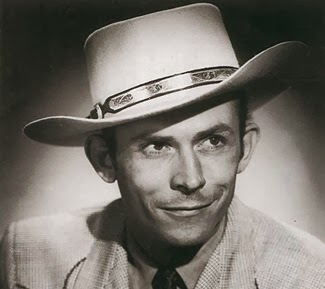With the recent passing of Phillip Seymour Hoffman of a drug overdose, and the many drug related deaths that have plagued Hollywood in recent years, I wanted to take a look at the drug overdoses that hit classic Hollywood. Accidental death by drug overdose is not something new, but in the older days of Hollywood it was hidden a lot better...
HANK WILLIAMS SR (1923-1953)
Hank was regarded as one of the most significant country music artists, Williams recorded 35 singles (five released posthumously) that would place in the Top 10 of the Billboard Country & Western Best Sellers chart, including 11 that ranked number one. Williams died extremely young of an accidental overdose of morphine and alcohol.
TOMMY DORSEY (1905-1956)
Tommy was an American jazz trombonist, trumpeter, composer, and bandleader of the Big Band era. He had such great vocalists as Frank Sinatra, Jo Stafford, and The Pied Pipers working for his organization at one time or another. Dorsey did not die of a drug overdose exactly but he died of the effects of it. He choked to death while sleeping. He was so sedated on sleeping pills that he was unable to awaken.
MARLYN MONROE (1926-1962)
One of the most famous celebrity cases of drug overdose was that of Marilyn Monroe. Over fifty years after her death, Monroe is still a viable icon of classic Hollywood. Looking back at her film roles in
Bus Stop (1956) and
Some Like It Hot (1959), she was a great actress as well. Monroe was found dead of a barbiturate overdose. Officially listed as "probable suicide" though several conspiracy theories exist.
DINAH WASHINGTON (1924-1963)
Dinah was an American singer and pianist, who has been cited as "the most popular black female recording artist of the '50sEarly on the morning of December 14, 1963, Washington's seventh husband Lane went to sleep with his wife, and awoke later to find her slumped over and not responsive. Doctor B. C. Ross came to the scene to pronounce her dead. An autopsy later showed a lethal combination of secobarbital and amobarbital, which contributed to her death at the age of 39.
ALAN LADD (1913-1964)
Alan was an American film actor and one of the great celebrities of the 1940s and early 1950s. After this, his fame diminished, though he continued to appear in popular films until his premature death. In November of 1962, Ladd attempted suicide by shooting himself but survived. On January 29, 1964 he was found dead in Palm Springs, California, of an acute overdose of "alcohol and three other drugs", at the age of 50; his death was ruled accidental.
DOROTHY DANDRIDGE (1922-1965)
Dorothy was an American actress and singer. Dandridge was the first black actress to be nominated for an Academy Award for Best Actress. On September 8, 1965, Dandridge was scheduled to fly to prepare for her nightclub engagement at Basin Street East. Several hours after her conversation with Branton ended, Dandridge was found dead by her manager, Earl Mills. Two months later, a Los Angeles pathology institute determined the cause to be an accidental overdose of Imipramine, a tricyclic antidepressant.
SCOTTY BECKETT (1929-1968)
Scotty was an American child actor. He starred in the Our Gang and Rocky Jones, Space Ranger television series. As an adult actor, he continued making movies. On May 8, 1968, he checked into a Hollywood nursing home, needing medical attention after suffering a serious beating. He died two days later at age 38. Although pills and a note were found, no conclusion was made by the coroner as to the exact cause of death; however, some speculate he overdosed on barbiturates or alcohol.
NICK ADAMS (1931-1968)
Nick was noted for his roles in several Hollywood films during the 1950s and 1960s along with his starring role in the ABC television series The Rebel (1959). Decades after Adams' death from a prescription drug overdose at the age of 36, his widely publicized friendships with James Dean and Elvis Presley would stir speculation about both his private life and the circumstances of his death.
JUDY GARLAND (1922-1969)
One of the most famous child stars of all-time, Garland started taking drugs on the set of 1939's
The Wizard Of Oz. Her adult life was riddled with suicide attempts and drug overdoses. When Judy died in 1969, she was a shell of her formal self. Garland died of a secobarbital overdose Her death certificate states the overdose was "accidental" however there is speculation it was intentional.
PIER ANGELI (1932-1971)
Pier was an Italian-born television and film actress. Her American cinematographic debut was in the starring role of the 1951 film
Teresa, for which she won a Golden Globe Award. Twenty years later, she had been chosen to play a part in
The Godfather, but died before filming began of a barbiturate overdose.
ELVIS PRESLEY (1935-1977)
Presley was without a doubt, the king of rock 'n' roll. However, the last years of his life was filled with a very unhealthy lifestyle. The King literally died on the throne (toilet). Presley died of a cardiac arrhythmia. The autopsy found in his system "significant" levels of ethinamate, methaqualone, codeine and different barbiturates, including amobarbital, pentobarbital, and phenobarbital.
These are just some of the accidental drug overdoses of classic Hollywood. Many other classic stars were dimmed by drug overdoses associated with suicides. With all the glamour, fame, and money - it could not buy happiness. It could not buy happiness in the 1930s and 1940s Hollywood, just as it can not buy happiness in 2014. The death of Phillip Seymour Hoffman was not the first fatal drug overdose in Hollywood, and it will not be the last one...
















_01.jpg)












_01.jpg)
_01.jpg)



















